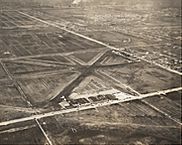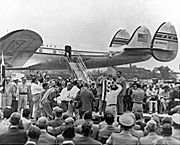| Entries |
| M |
|
Midway Airport
|

|
Private aircraft were the first planes to take off and land from the square-mile parcel of land leased by the city of Chicago from the Chicago Board of Education. In 1926 the city began leasing the field for commercial purposes. A single cinder runway served airmail traffic, and was dedicated Chicago Municipal Airport on December 12, 1927, offering mail, express, and passenger service. Officials rededicated the facility as Midway to honor the Pacific air and sea battle of World War II.
A bond issue funded construction of a passenger terminal and administration building in 1931, and federal grants in subsequent years covered major improvements in runway design, lighting, and safety and service features.

|
At what should have been its greatest hour, Midway fell prey to technological changes in aviation. The requirements of supersonic air travel, such as longer runways, drew carriers to larger and more convenient O'Hare. The city of Chicago provided sustaining infusions of cash to Midway investing $10 million in renovation funds in 1968, and supported construction of the nearby Stevenson Expressway as an artery to restore Midway's passenger supply. A few major carriers returned, but by 1976, only Delta Airlines continued to service the fallen giant.
Deregulation of the airline industry spurred entrepreneurship by new carriers and helped resuscitate the beleaguered airport after 1978. Upstart Midway Airlines formed to challenge major carrier dominance at O'Hare. It became the airport's flagship, supplying more than half of its passenger volume by 1990. Midway Airlines required reorganization, but the model inspired other carriers, such as Southwest Airlines. By the mid-1990s, Midway offered an alternative to O'Hare for cost-conscious travelers and families lured to the Southwest Side by competitive fares to popular destinations. Bolstered by construction of rapid transit service to the Loop, Midway has again become a vital circuit in Chicago's transportation system.
The Encyclopedia of Chicago © 2004 The Newberry Library. All Rights Reserved. Portions are copyrighted by other institutions and individuals. Additional information on copyright and permissions.